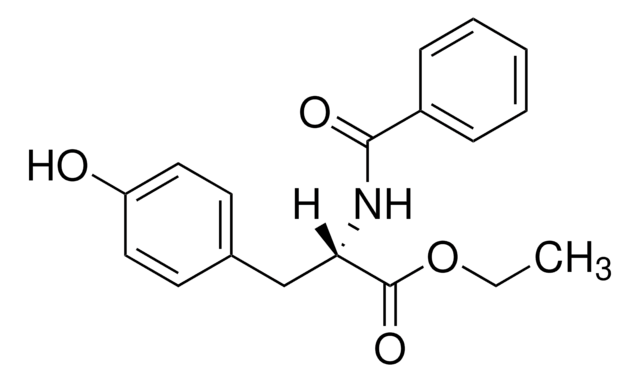C3881
Chlorure de calcium dihydrate
ReagentPlus®, ≥99.0%
Se connecterpour consulter vos tarifs contractuels et ceux de votre entreprise/organisme
About This Item
Formule empirique (notation de Hill):
CaCl2 · 2H2O
Numéro CAS:
Poids moléculaire :
147.01
Numéro CE :
Numéro MDL:
Code UNSPSC :
12352300
ID de substance PubChem :
Nomenclature NACRES :
NA.21
Essai:
≥99.0%
Forme:
powder
Produits recommandés
Pression de vapeur
0.01 hPa ( 20 °C)
Niveau de qualité
Gamme de produits
ReagentPlus®
Essai
≥99.0%
Forme
powder
pH
5-8 (25 °C, 147 g/L)
Pf
176 °C (dec.) (lit.)
Chaîne SMILES
O.O.Cl[Ca]Cl
InChI
1S/Ca.2ClH.2H2O/h;2*1H;2*1H2/q+2;;;;/p-2
Clé InChI
LLSDKQJKOVVTOJ-UHFFFAOYSA-L
Vous recherchez des produits similaires ? Visite Guide de comparaison des produits
Catégories apparentées
Description générale
Calcium chloride dihydrate is an inorganic compound that is commonly used as an environmentally friendly catalyst in organic synthesis. It is also used in asymmetric transformation reactions.
Application
Calcium chloride dihydrate can be used as a catalyst:
It can also be used as a calcium precursor to synthesize macro/mesoporous dicalcium phosphate monolith (CaHPO4) via the sol-gel method using phosphoric acid (H3PO4), and poly(acrylic acid) (PAA).
- In the asymmetric 1,4-addition and [3+2]-cycloaddition reactions in the presence of box-type ligands.
- To synthesize hexahydropyrimidine derivatives via a one-pot three-component condensation reaction of ethyl/methyl acetoacetate, aniline, and formaldehyde.
It can also be used as a calcium precursor to synthesize macro/mesoporous dicalcium phosphate monolith (CaHPO4) via the sol-gel method using phosphoric acid (H3PO4), and poly(acrylic acid) (PAA).
Informations légales
ReagentPlus is a registered trademark of Merck KGaA, Darmstadt, Germany
Mention d'avertissement
Warning
Mentions de danger
Conseils de prudence
Classification des risques
Eye Irrit. 2
Code de la classe de stockage
13 - Non Combustible Solids
Classe de danger pour l'eau (WGK)
WGK 1
Point d'éclair (°F)
Not applicable
Point d'éclair (°C)
Not applicable
Faites votre choix parmi les versions les plus récentes :
Déjà en possession de ce produit ?
Retrouvez la documentation relative aux produits que vous avez récemment achetés dans la Bibliothèque de documents.
Les clients ont également consulté
Dante Pascual Goy et al.
The open biomedical engineering journal, 6, 85-91 (2012-08-01)
At present, typical approaches employed to repair fractures and other bone lesions tend to use matrix grafts to promote tissue regeneration. These grafts act as templates, which promote cellular adhesion, growth and proliferation, osteoconduction, and even osteoinduction, which commonly results
Danielle Wu et al.
Proceedings of the National Academy of Sciences of the United States of America, 110(29), 12096-12101 (2013-07-03)
Osteocytes are bone cells that form cellular networks that sense mechanical loads distributed throughout the bone tissue. Interstitial fluid flow in the lacunar canalicular system produces focal strains at localized attachment sites around the osteocyte cell process. These regions of
Chao-Lin Chen et al.
Scientific reports, 9(1), 10616-10616 (2019-07-25)
Autologous vascular grafts have the advantages of better biocompatibility and prognosis. However, previous studies that implanted bare polymer tubes in animals to grow autologous tubular tissues were limited by their poor yield rates and stability. To enhance the yield rate
Sophie Lanone et al.
Particle and fibre toxicology, 6, 14-14 (2009-05-02)
A critical issue with nanomaterials is the clear understanding of their potential toxicity. We evaluated the toxic effect of 24 nanoparticles of similar equivalent spherical diameter and various elemental compositions on 2 human pulmonary cell lines: A549 and THP-1. A
Balmiki Ray et al.
Brain research, 1297, 160-168 (2009-08-08)
Cholinergic neurons are a major constituent of the mammalian central nervous system. Acetylcholine, the neurotransmitter used by cholinergic neurons, is synthesized from choline and acetyl CoA by the enzymatic action of choline acetyltransferase (ChAT). The transport of choline into the
Notre équipe de scientifiques dispose d'une expérience dans tous les secteurs de la recherche, notamment en sciences de la vie, science des matériaux, synthèse chimique, chromatographie, analyse et dans de nombreux autres domaines..
Contacter notre Service technique





